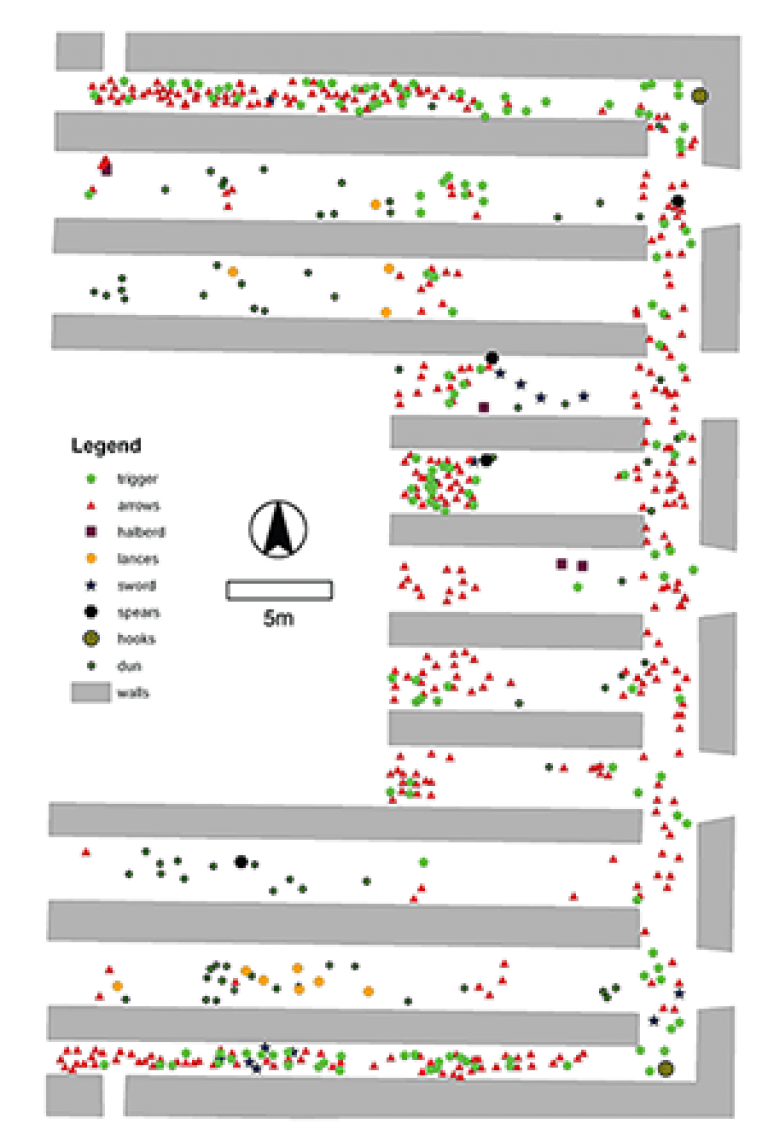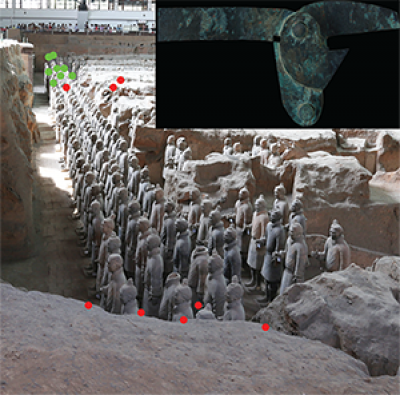What's so special… and spatial… about the Terracotta Army?
26 February 2014
Janice Li's mapping of the weapons in Pit 1.

We've been getting some nice publicity recently due to a Channel 4 documentary that has featured our collaborative work on the terracotta warriors and their weapons. We've also got some papers out or on the way, that discuss in a bit more detail our project methods and results. In fact, a lot of what we have had to say has had a strong 'spatial' component. By this I mean, that we are rarely interested only in Qin warriors and weapons as if they had been unearthed at random (i.e. as if they were just one enormous bag of finds from an unknown find-spot), but instead, thanks to the excellent recording methods of the excavators at locations such as the vast "Pit 1", we can explore what additional information the spatial distribution of warriors or their weapons can offer. Janice Li first began looking at the warriors and weapons in this way on behalf of our project, and we have been following that lead ever since (in Pit 1 especially).
It turns out that while "distribution maps" have long been important for archaeological interpretation, the spatial patterns of the Terracotta Army are far cooler to play with than your run-of-the-mill data. Here are some reasons why:

- Different types of warriors (generals, infantry, crossbowmen, charioteers) are laid out in a real battle formation, so by studying who goes in what position in that formation, we can learn a lot about Qin military tactics.
- While Pit 1 and other pits were likely designed in one go and laid out during a single reign, the cramped nature of the pit still means that the warriors must have been placed and equipped in a certain chronological order. It's difficult but compelling work to try to find out things like whether the army was constructed front to back or corridor-by-corridor, how many warriors were set up in one go, or the size of the likely labour force involved.
- Although certain aspects of the warriors' weapons are incredibly standardised, tiny stylistic and technical details are still recognisable once you look very carefully. These typically relate to the different moulds used to cast these bronze weapons and can also speak to us about different possible workshops and workers. Mapping these micro-differences in weapons and weapon sub-parts across Pit 1 in the mausoleum complex for example, then shows us if these workshops delivered their products in one go or not. We can also infer a lot about whether the workers were operating in small, self-sufficient cells (very probably) or as part of a large assembly line (less likely).
- From my own slightly nerdy perspective, the fact that we want to know about a spatial pattern (stylistic variability) within a spatial pattern (the military formation) is a real statistical challenge, but a tractable one. Indeed, we can try the same tricks, not only for the bronze weapons, but for the warriors themselves: looking for tiny variation in styles of warrior manufacture and then mapping out these differences spatially.
The niftiest thing for me about all this is that the incidental details of manufacture really matter in pushing forward what we know about this amazing site. And whether you're looking at the ear lobes of individual warriors, the firing mechanisms of crossbow triggers or the lethality of arrowheads, the details always tell you even more when you map them out.

Andrew Bevan is a Professor at the UCL Institute of Archaeology and is the Deputy Director of the Imperial Logistics Project.
 Close
Close

